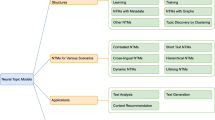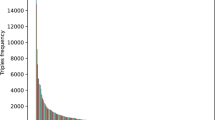Abstract
As few-shot relation classification requires less data to train the neural network models, high costs related to data collection and labeling are eliminated. Compared with the traditional few-shot task, the interdisciplinary few-shot relation classification faces many semantic gap issues (e.g., common sense, subject terminology and insufficient migratable information), bringing the linguistic bias between the testing phase and the training phase. Previous methods mainly focus on the training phase itself and neglect the inherent syntactic and semantic heterogeneity in terms of gap issues. In this paper, we propose a Domain-Aware Prototypical Network (DPNet) to cast the interdisciplinary few-shot relation classification as a covariate shift task. First, the relational keyword masking mechanism, which masks the keywords with a certain probability, is adopted to learn the contextual structure information. Second, to reduce the influence of subject-specific terminology, the adaptive word mover’s distance (WMD) is proposed to calculate the similarity among test samples by weighting each word in the sentence. Third, the knowledge distillation strategy integrates each category distribution characteristic into a prototypical network, which supplements additional information for metric learning in task-adaptive feature sub-space. We conduct various experiments on two widely used benchmarks (FewRel 2.0 and DDI-13 dataset). Experimental results show that our model outperforms related methods by a significant margin.





Similar content being viewed by others
References
Han X, Zhu H, Yu P, Wang Z, Yao Y, Liu Z, Sun M (2018) FewRel: A large-scale supervised few-shot relation classification dataset with state-of-the-art evaluation. In: Proceedings of the 2018 conference on empirical methods in natural language processing. Association for Computational Linguistics, Brussels, Belgium, pp 4803–4809
Wu F, Smith JS, Lu W, Pang C, Zhang B (2020) Attentive prototype few-shot learning with capsule network-based embedding. Proceedings of the European Conference on Computer Vision 12373:237–253
Vinyals O, Blundell C, Lillicrap T, kavukcuoglu, Wierstra D (2016) Matching networks for one shot learning. In: Lee D, Sugiyama M, Luxburg U, Guyon I, Garnett R (eds) proceedings of the neural information processing systems conference, pp 3630–3638
Cong X, Yu B, Liu T, Cui S, Tang H, Wang B (2020) Inductive unsupervised domain adaptation for few-shot classification via clustering. In: Proceedings of the 2020 European conference on machine learning and principles and practice of knowledge discovery in database
Gao T, Han X, Liu Z, Sun M (2019) Hybrid attention-based prototypical networks for noisy few-shot relation classification. Proceedings of the AAAI Conference on Artificial Intelligence 33(01):6407–6414
Devlin J, Chang M-W, Lee K, Toutanova K (June 2019) BERT: Pre-training of deep bidirectional transformers for language understanding. In: Proceedings of the 2019 conference of the North American chapter of the association for computational linguistics: human language technologies, volume 1 (long and short papers). Association for Computational Linguistics, Minneapolis, Minnesota, pp 4171–4186
Liu Y, Ott M, Goyal N, Du J, Joshi M, Chen D, Levy O, Lewis M, Zettlemoyer L, Stoyanov V (1907) Roberta: A robustly optimized bert pretraining approach, 2019. arXiv:1907.11692 364
Raffel C, Shazeer N, Roberts A, Lee K, Narang S, Matena M, Zhou Y, Li W, Liu PJ (2020) Exploring the limits of transfer learning with a unified text-to-text transformer. J Mach Learn Res 21(140):1–67
Lewis M, Liu Y, Goyal N, Ghazvininejad M, Mohamed A, Levy O, Stoyanov V, Zettlemoyer L (2020) BART: Denoising sequence-to-sequence pre-training for natural language generation, translation, and comprehension. In: Proceedings of the 58th annual meeting of the association for computational linguistics. Association for computational linguistics, Online, pp 7871–7880
Snell J, Swersky K, Zemel RS (2017) Prototypical networks for few-shot learning. In: Guyon I, von Luxburg U, Bengio S, Wallach H M, Fergus R, Vishwanathan S V N, Garnett R (eds) Proceedings of the 2017 conference and workshop on neural information processing systems, pp 4077–4087
Wen W, Liu Y, Ouyang C, Lin Q, Chung T (2021) Enhanced prototypical network for few-shot relation extraction. Information Processing & Management 58(4):102596
Huang P-S, Wang C, Singh R, Yih W, He X (2018) Natural language to structured query generation via meta-learning. In: Proceedings of the 2018 conference of the North American chapter of the association for computational linguistics: human language technologies, volume 2 (short papers). Association for Computational Linguistics, New Orleans, Louisiana, pp 732–738
Yu C, Han J, Zhang H, Ng W (2020) Hypernymy detection for low-resource languages via meta learning. In: Proceedings of the 58th annual meeting of the association for computational linguistics. Association for Computational Linguistics, pp 3651–3656
Finn C, Abbeel P, Levine S (2017) Model-agnostic meta-learning for fast adaptation of deep networks. Proceedings of the 2017 International Conference on Machine Learning, abs/1703.03400
Wohlwend J, Elenberg ER, Altschul S, Henry S, Lei T (2019) Metric learning for dynamic text classification. In: Proceedings of the 2nd workshop on deep learning approaches for low-resource NLP (DeepLo 2019). Association for Computational Linguistics, Hong Kong, China, pp 143–152
Xiong S, Zhang Y, Ji D, Lou Y (2016) Distance metric learning for aspect phrase grouping. In: Proceedings of COLING 2016, the 26th international conference on computational linguistics: technical papers. The COLING 2016 Organizing Committee, Osaka, Japan, pp 2492–2502
Bengio Y, Bengio S, Cloutier J (1991) Learning a synaptic learning rule. In: Proceedings of the IJCNN-91-seattle international joint conference on neural networks, vol ii, pp 969 vol.2–
Ravi S, Larochelle H (2017) Optimization as a model for few-shot learning.. In: Proceedings of the 2017 international conference on learning representations
Li Z, Zhou F, Chen F, Li H (2017) Meta-sgd: Learning to learn quickly for few shot learning. Computing Research Repository, abs/1707.09835
Bansal T, Jha R, Munkhdalai T, McCallum A (November 2020) Self-supervised meta-learning for few-shot natural language classification tasks. In: Proceedings of the 2020 Conference on Empirical Methods in Natural Language Processing (EMNLP). Association for Computational Linguistics, Online, pp 522–534
Rusu AA, Rao D, Sygnowski J, Vinyals O, Pascanu R, Osindero S, Hadsell R (2018) Meta-learning with latent embedding optimization. CoRR abs/1807.05960
Finn C, Abbeel P, Levine S (2017) Model-agnostic meta-learning for fast adaptation of deep networks. In: Precup D, Teh YW (eds) Proceedings of the 34th international conference on machine learning. Proceedings of Machine Learning Research, vol 70. PMLR, pp 1126–1135
Lee K, Maji S, Ravichandran A, Soatto S (2019) Meta-learning with differentiable convex optimization. In: Proceedings of the IEEE/CVF Conference on Computer Vision and Pattern Recognition (CVPR)
Hidalgo, Ángel Casado, Moreno P, Valent?n, Luis (2021) Using meta-learning to predict student performance in virtual learning environments. In: Applied intelligence
Dou Z-Y, Yu K, Anastasopoulos A (November 2019) Investigating meta-learning algorithms for low-resource natural language understanding tasks. In: Proceedings of the 2019 conference on empirical methods in natural language processing and the 9th international joint conference on natural language processing (EMNLP-IJCNLP). Association for Computational Linguistics, Hong Kong, China, pp 1192–1197
Satorras VG, Estrach JB (2018) Few-shot learning with graph neural networks. In: Proceedings of the 2018 international conference on learning representations
Mishra N, Rohaninejad M, Chen X, Abbeel P (2018) A simple neural attentive meta-learner.. In: Proceedings of the 2018 international conference on learning representations. OpenReview.net
Geng X, Chen X, Zhu KQ, Shen L, Zhao Y (2020) Mick: A meta-learning framework for few-shot relation classification with small training data. Proceedings of the 29th ACM International Conference on Information & Knowledge Management
Wang Y, Bao J, Liu G, Wu Y, He X, Zhou B, Zhao T (2020) Learning to decouple relations: Few-shot relation classification with entity-guided attention and confusion-aware training. In: Proceedings of the 28th International Conference on Computational Linguistics. International committee on computational linguistics, Barcelona, Spain (Online), pp 5799–5809
Dong B, Yao Y, Xie R, Gao T, Han X, Liu Z, Lin F, Lin L (2019) Meta-information guided meta-learning for few-shot relation classification. In: Proceedings of the 28th International Conference on Computational Linguistics. International committee on computational linguistics, Barcelona, Spain (Online), pp 1594–1605
Qu M, Gao T, Xhonneux L-P, Tang J (2020) Few-shot relation extraction via bayesian meta-learning on relation graphs. In: III HD, Singh A (eds) Proceedings of the 37th international conference on machine learning. Proceedings of Machine Learning Research, vol 119. PMLR, pp 7867–7876
Koch GR (2015) Siamese neural networks for one-shot image recognition
Fan M, Bai Y, Sun M, Li P (2019) Large margin prototypical network for few-shot relation classification with fine-grained features. In: Zhu W, Tao D, Cheng X, Cui P, Rundensteiner E A, Carmel D, He Q, Yu JX (eds) Proceedings of the 2019 ACM international conference on information and knowledge management. ACM, pp 2353–2356
Ren H, Cai Y, Chen X, Wang G, Li Q (2020) A two-phase prototypical network model for incremental few-shot relation classification. In: Proceedings of the 28th international conference on computational linguistics. International Committee on Computational Linguistics, Barcelona, Spain (Online), pp 1618–1629
Ding N, Wang X, Fu Y, Xu G, Wang R, Xie P, Shen Y, Huang F, Zheng H-T, Zhang R (2021) Prototypical representation learning for relation extraction. In: Proceedings of the 2021 international conference on learning representations
Wang, Fei, LiChen, ZengZhen, XuKe, Cheng, LiuYanjun (2021) Cornerstone network with feature extractor: a metric-based few-shot model for chinese natural sign language. In: Applied intelligence
Ye Z-X, Ling Z-H (July 2019) Multi-level matching and aggregation network for few-shot relation classification. In: Proceedings of the 57th annual meeting of the association for computational linguistics. Association for Computational Linguistics, Florence, Italy, pp 2872–2881
Xie Y, Xu H, Li J, Yang C, Gao K (2020) Heterogeneous graph neural networks for noisy few-shot relation classification. Knowl Based Syst 194:105548
Wu L, Zhang H-P, Yang Y, Liu X, Gao K (2020) Dynamic prototype selection by fusing attention mechanism for few-shot relation classification. In: Nguyen N T, Jearanaitanakij K, Selamat A, Trawinski B, Chittayasothorn S (eds) ACIIDS (1). Lecture Notes in Computer Science. Springer, pp 431–441
Sung F, Yang Y, Zhang L, Xiang T, Torr PHS, Hospedales TM (2018) Learning to compare: Relation network for few-shot learning. In: 2018 IEEE/CVF Conference on Computer Vision and Pattern Recognition, pp 1199–1208
Wu Z, Li Y, Guo L, Jia K (2019) Parn: Position-aware relation networks for few-shot learning. In: Proceedings of the IEEE/CVF International Conference on Computer Vision (ICCV)
Wang Z, Zhao Y, Li J, Tian Y (2020) Cooperative bi-path metric for few-shot learning. Proceedings of the 28th ACM International Conference on Multimedia
Hinton G, Vinyals O, Dean J (2014) Distilling the knowledge in a neural network. Proceedings of the 2014 Conference and Workshop on Neural Information Processing Systems
Kusner MJ, Sun Y, Kolkin NI, Weinberger KQ (2015) From word embeddings to document distances. In: Proceedings of the 32Nd international conference on international conference on machine learning - volume 37. ICML’15. JMLR.org, pp 957– 966
Baldini Soares L, FitzGerald N, Ling J, Kwiatkowski T (July 2019) Matching the blanks: Distributional similarity for relation learning. In: Proceedings of the 57th annual meeting of the association for computational linguistics. Association for Computational Linguistics, Florence, Italy, pp 2895–2905
Peng H, Gao T, Han X, Lin Y, Li P, Liu Z, Sun M, Zhou J (2020) Learning from Context or Names? An Empirical Study on Neural Relation Extraction. In: Proceedings of the 2020 Conference on Empirical Methods in Natural Language Processing (EMNLP). Association for Computational Linguistics, Online, pp 3661–3672
Author information
Authors and Affiliations
Corresponding author
Additional information
Publisher’s note
Springer Nature remains neutral with regard to jurisdictional claims in published maps and institutional affiliations.
Rights and permissions
About this article
Cite this article
Lv, B., Jin, L., Li, X. et al. DPNet: domain-aware prototypical network for interdisciplinary few-shot relation classification. Appl Intell 52, 15718–15733 (2022). https://doi.org/10.1007/s10489-022-03210-2
Accepted:
Published:
Issue Date:
DOI: https://doi.org/10.1007/s10489-022-03210-2




